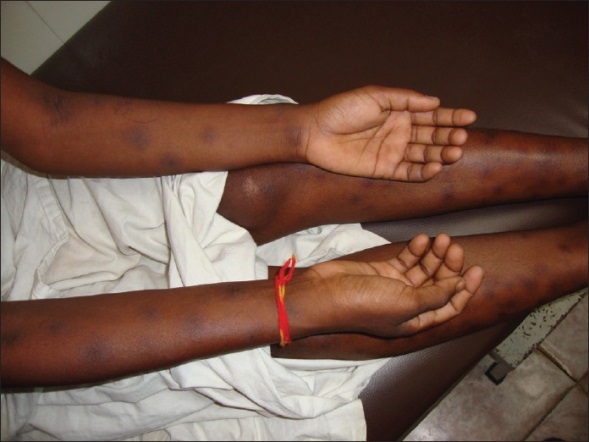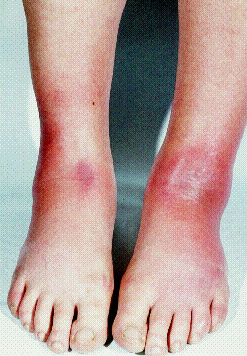Located in a certain part of the fatty layer of skin, erythema nodosum is skin inflammation that causes painful, reddish, tender lumps to appear in the front of your legs right below the knees. The tender nodules or lumps of erythema nodosum vary in size and can be anywhere between 1cm and 5cm. Mild cases of erythema nodosum are usually self-limiting and do not require medical intervention. They usually take about 3-6 weeks to clear completely. Once they resolve, you may notice chronic indentation or a temporary bruise on your skin, which can be seen in erythema nodosum pictures.
What does Erythema Nodosum Look Like?
The most common symptom of this skin condition is the development of warm, painful, and reddish lumps or nodules. These lumps usually appear in areas such as knees, shins, face and neck, forearms, ankles, and thighs. A look at erythema nodosum pictures will help you identify.
Once you develop this condition, you may also experience generalized achiness, fever, joint pain, and leg swelling. Your nodules may start to clear within a couple of weeks, but it is also possible to see new lesions develop for up to 6 weeks. However, chronic erythema nodosum is different and may occur intermittently, leaving a bruised appearance.
Erythema Nodosum Pictures
Erythema nodosum nodules are slightly red in color and painful too. These nodules most commonly appear on the shins but can show up on your arms and other areas as well. Here are some picturesto help you identify these nodules.




Why Does It Occur?
The condition can affect people from any age group, sex, and ethnicity. However, it is more common in young adults, and women in particular, who are 4 times more likely than men to develop erythema nodosum. There may or may not be any underlying cause; in fact, 30-50% of cases of erythema nodosum usually have no underlying cause. Some people develop it because of an infection associated medication, or health condition.
- You may develop this condition if you are taking estrogen pills or other birth control pills. You may also get it if you are taking antibiotics such as penicillin or sulfonamide.
- You are at a greater risk of developing this condition if you already have an infection, such as tuberculosis, intestinal infections, streptococcal infections, pneumonia, or fungal infections.
- You may end up developing erythema nodosum if you are pregnant, have lymphoma or leukemia, or are suffering from an inflammatory bowel disease.
How Is It Treated?
Once you believe you have the symptoms and your nodules are the same you have seen in erythema nodosum pictures, you may want to talk to your doctor who will first identify the underlying cause, which could be infection, medication, or medical condition. They may also order certain tests, including chest x-rays, blood tests, and throat culture to make a correct diagnosis. They will treat the underlying cause first, if it is present. The most common treatment options include:
- Non-steroidal anti-inflammatory drugs to relieve pain
- Leg elevation and cool compresses to relieve swelling
- Treatment of underlying health condition
The condition usually resolves on its own within 3-6 weeks. All you have to do is take complete bed rest and apply cool compresses to the affected area to reduce swelling. Keep your legs elevated as often as possible and take anti-inflammatory drugs to reduce pain. Your doctor may prescribe potassium iodide tablets in some cases to decrease inflammation.
Corticosteroids also prove effective. These oral medications are usually prescribed when your symptoms become worse and do not improve after taking non-steroidal anti-inflammatory drugs. It is equally important to stop taking drugs that may have caused this condition in the first place. Your doctor may give antibiotics as well, if your skin disorder is due to a streptococcal infection.
Self-Care at Home
While erythema nodosum resolves on its own, you may want to see a doctor to ensure no underlying condition or medication has caused it in the first place. Your doctor will discuss everything with you and identify possible health problems. However, you can also take self-care measures to improve your condition. For instance:
- Keep yourself from engaging in any physical activity for some time.
- Keep your legs elevated if they are affected.
- Apply warm or cold compresses to reduce discomfort.
